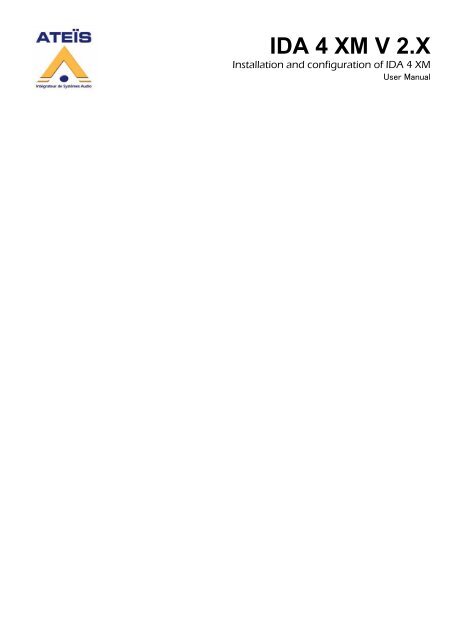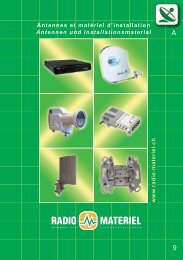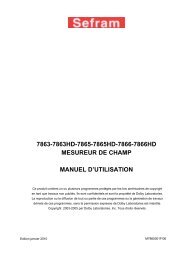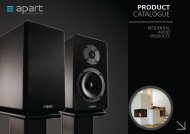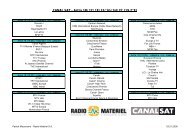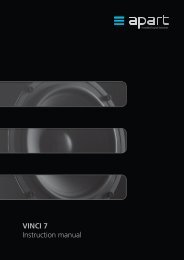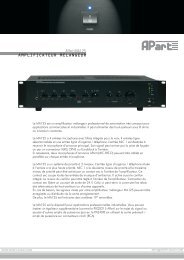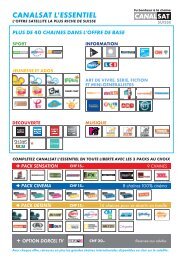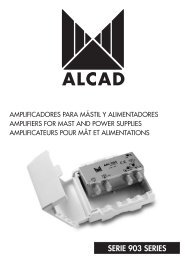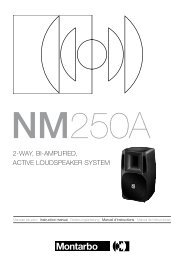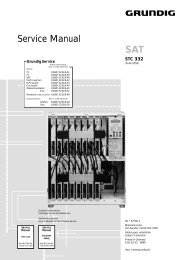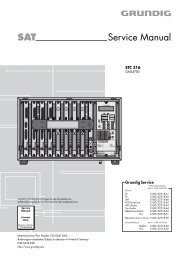IDA 4 XM V 2.X - Radio Matériel
IDA 4 XM V 2.X - Radio Matériel
IDA 4 XM V 2.X - Radio Matériel
Create successful ePaper yourself
Turn your PDF publications into a flip-book with our unique Google optimized e-Paper software.
<strong>IDA</strong> 4 <strong>XM</strong> V <strong>2.X</strong><br />
Installation and configuration of <strong>IDA</strong> 4 <strong>XM</strong><br />
User Manual
IMPORTANT SAFETY INSTRUCTIONS<br />
- Switch the device’s power off before any maintenance operation (changing the CU card, etc.)<br />
- The 24V power supply voltage should be between 20V and 28V.<br />
- The maximum admissible wattage per amplifier channel is 500W effective power.<br />
Customer Support <strong>Radio</strong> Matériel S.A<br />
Avenue des Baumettes 21<br />
1020 Renens<br />
Switzerland<br />
+41 21 633 58 00<br />
+41 21 633 58 01<br />
User_manual_<strong>IDA</strong>4<strong>XM</strong>_V2.x.doc<br />
Page 2 of 51
CONTENTS<br />
1 SOFTWARE_______________________________________________________________________ 4<br />
1.1 PRESENTATION______________________________________________________________ 4<br />
1.2 MAIN ________________________________________________________________________ 5<br />
1.3 SETTINGS ___________________________________________________________________ 7<br />
1.3.1 Application ________________________________________________________________ 7<br />
1.3.2 Site ______________________________________________________________________ 9<br />
1.3.3 Zones____________________________________________________________________ 11<br />
1.3.4 Call stations & messages ____________________________________________________ 16<br />
1.3.5 Evacuation inputs __________________________________________________________ 29<br />
1.3.6 Control inputs _____________________________________________________________ 31<br />
1.3.7 Sources (0dB inputs)________________________________________________________ 34<br />
1.3.8 Serial ports _______________________________________________________________ 39<br />
1.3.9 Fault inputs _______________________________________________________________ 42<br />
1.4 FAULT DESCRIPTION _______________________________________________________ 43<br />
1.4.1 Fault type ________________________________________________________________ 43<br />
1.4.2 Fault consequences _________________________________________________________ 43<br />
1.4.3 Fault list _________________________________________________________________ 44<br />
1.5 MONITORING_______________________________________________________________ 46<br />
2 HARDWARE _____________________________________________________________________ 48<br />
2.1 REAR PANEL CONNECTIONS ________________________________________________ 48<br />
2.2 BASE WIRING DIAGRAM ____________________________________________________ 49<br />
2.3 MASTER – SLAVE WIRING DIAGRAM ________________________________________ 50<br />
2.4 PC – <strong>IDA</strong> WIRING DIAGRAM _________________________________________________ 51<br />
2.5 TECHNICAL FEATURES _____________________________________________________ 51<br />
User_manual_<strong>IDA</strong>4<strong>XM</strong>_V2.x.doc<br />
Page 3 of 51
1 SOFTWARE<br />
1.1 PRESENTATION<br />
The PC<strong>IDA</strong>4<strong>XM</strong> software is composed of three windows :<br />
1.1 Main for general settings<br />
Communication<br />
Appearance<br />
<strong>IDA</strong> updating (date and time, internal software)<br />
Language<br />
1.2 Settings for application settings (site, zones, call stations, messages,…)<br />
Site<br />
Zones<br />
Call stations and messages<br />
Evacuation inputs<br />
Control inputs<br />
Sources (0dB inputs)<br />
Serial ports<br />
Fault inputs<br />
1.3 Monitoring for the selection of signal which has to be routed to the monitoring loudspeaker<br />
(8 ohms).<br />
User_manual_<strong>IDA</strong>4<strong>XM</strong>_V2.x.doc<br />
Page 4 of 51
1.2 MAIN<br />
Serial port Windows Language<br />
Serial port<br />
Connection<br />
Windows<br />
The roll list Serial port enables the choice of the serial port on which the communication<br />
between the PC and <strong>IDA</strong> has to be established.<br />
In case of failure, for example the selected port is not configured in the PC, the<br />
corresponding list item indicates COM X : HS. Otherwise, it indicates COM X : OK.<br />
By clicking on the check button Connection, the PC tries to communicate with the<br />
connected <strong>IDA</strong>.<br />
In case of success of the connection between the PC and <strong>IDA</strong>, the check button<br />
Connection indicates the following message : Connected to <strong>IDA</strong> V1.X.<br />
In case of failure of the connection between the PC and <strong>IDA</strong>, the message box NO <strong>IDA</strong> !<br />
appears on the screen and the check button indicates Not connected.<br />
The command button Windows saves the current position of the different windows on the<br />
screen.<br />
By new start of the PC<strong>IDA</strong>4<strong>XM</strong> software, the windows will appear on the screen as saved<br />
by the last click on the command button Windows.<br />
User_manual_<strong>IDA</strong>4<strong>XM</strong>_V2.x.doc<br />
Page 5 of 51
Set Date/Time<br />
The command button Set Date/Time enables the updating of date and time in <strong>IDA</strong>.<br />
The source can be either the PC or an external clock.<br />
By clicking on the command button Date & Time, the message box Date and time<br />
updating by PC ? appears on the screen. By clicking on the button OK, the date and time<br />
is sent by the PC on <strong>IDA</strong>. By clicking on the button Cancel, a new message box Date and<br />
time updating by an external clock ? appears on the screen. By clicking on the button<br />
OK, a date and time updating request is sent to the external clock.<br />
<strong>IDA</strong> Updating<br />
Language<br />
The command button <strong>IDA</strong> Updating enables the updating of the <strong>IDA</strong>4 firmware.<br />
To update <strong>IDA</strong>4, the following procedure has to be done :<br />
• Connect <strong>IDA</strong>4 master with all <strong>IDA</strong>4 slaves (if <strong>IDA</strong>4 slaves are present).<br />
• Switch on power on all <strong>IDA</strong>4.<br />
• The <strong>IDA</strong>4’s number which is displayed on <strong>IDA</strong>4 master display must match with the<br />
real <strong>IDA</strong>4’s number. If not, select the right Number of <strong>IDA</strong>4 on SETTINGS windows<br />
(see part 1.3) and download the configuration in <strong>IDA</strong>4’s memory using the command<br />
button Write. Then, switch off and on power on all <strong>IDA</strong>4.<br />
• Click on the command button <strong>IDA</strong> Updating to update <strong>IDA</strong> master and slaves<br />
All the <strong>IDA</strong> will be updated.<br />
The roll list Language enables the choice of the language.<br />
You will have to restart the software to have the new language activated.<br />
User_manual_<strong>IDA</strong>4<strong>XM</strong>_V2.x.doc<br />
Page 6 of 51
1.3 SETTINGS<br />
1.3.1 Application<br />
Items<br />
Number of <strong>IDA</strong><br />
Items<br />
The roll list Items enables the choice of the item which has to be configured. All options of<br />
each item are defined in the following parts.<br />
Number of <strong>IDA</strong><br />
Read<br />
The roll list Number of <strong>IDA</strong> defines the number of <strong>IDA</strong> which are present in the current<br />
application. Up to 64 <strong>IDA</strong> can be configured in the application.<br />
When you start to set up, the first thing to do is to select the number of <strong>IDA</strong> cascaded in the<br />
system (including the master).<br />
The command button Read reads the settings saved in <strong>IDA</strong>’s memory and displays the<br />
dataset on the screen.<br />
User_manual_<strong>IDA</strong>4<strong>XM</strong>_V2.x.doc<br />
Page 7 of 51
Write<br />
The command button Write loads in <strong>IDA</strong>’s memory the current dataset which is<br />
corresponding to the settings displayed on the screen.<br />
You have to write the configuration in the <strong>IDA</strong> system to activate it.<br />
Restart<br />
Import<br />
Export<br />
The command button Restart resets the program in <strong>IDA</strong>.<br />
The command button Import reads the settings saved in the selected file stored in the PC<br />
and displays the dataset on the screen.<br />
The command button Export saves in the selected PC file the current dataset which is<br />
corresponding to the settings displayed on the screen.<br />
User_manual_<strong>IDA</strong>4<strong>XM</strong>_V2.x.doc<br />
Page 8 of 51
1.3.2 Site<br />
SITE > GENERAL<br />
Name<br />
Password<br />
Music<br />
The text box Name defines the name of the application.<br />
The maximal length of the application name is 16 alphanumerical characters.<br />
The text box Password defines the password of the application.<br />
The maximal length of the password is 8 numerical characters.<br />
The roll list Music enables the music start or stop.<br />
• Change… Music mode can be changed through the call stations<br />
• Music ON Starting music<br />
• Music OFF Stopping music<br />
User_manual_<strong>IDA</strong>4<strong>XM</strong>_V2.x.doc<br />
Page 9 of 51
The check button Automatic Music can be enabled only if the check button Automatic<br />
Level change is enabled. Music is played only during the timetable defined through the text<br />
zones Normal and Reduced.<br />
Fault display<br />
The check button Fault display enables the display of faults on call stations.<br />
Complete log<br />
The check button Complete log selects the events which are saved in the log memory.<br />
If Complete log is enable, all events are saved in the log memory. Otherwise, only security<br />
events are saved.<br />
Reduced level<br />
Loud level<br />
The slider Reduced level adjusts the level in reduced mode.<br />
The adjustment can be defined between –12 and 0 dB.<br />
The slider Loud level adjusts the level in loud mode.<br />
The adjustment can be defined between 0 and +12 dB.<br />
Level change<br />
The roll list Level change defines the general level of the application.<br />
• Change… General level can be changed on call stations<br />
• Reduced General level is reduced to the adjusted level<br />
• Loud General level is increased to the loud level<br />
• Normal General level is set to the normal level<br />
.<br />
The check button Automatic enables the automatic change of level.<br />
Text boxes Normal and Reduced define the timetables for the change.<br />
English display<br />
Max calls<br />
• Normal Level changes from reduced to normal<br />
• Reduced Level changes from normal to reduced<br />
If the check button English display is selected, all texts are displayed on <strong>IDA</strong>4 and call<br />
stations in English language. Otherwise, al texts are displayed in French language.<br />
The slider Max calls defines the length of a call. The call station microphone is ON during<br />
the defined length.<br />
If the slider Max calls is positioned on the left side, there is no length limitation<br />
User_manual_<strong>IDA</strong>4<strong>XM</strong>_V2.x.doc<br />
Page 10 of 51
1.3.3 Zones<br />
Four zones can be configured on each <strong>IDA</strong>.<br />
ZONES > GENERAL<br />
Name<br />
The text box Name defines the name of the zone.<br />
The maximal length of the application name is 11 alphanumerical characters.<br />
User_manual_<strong>IDA</strong>4<strong>XM</strong>_V2.x.doc<br />
Page 11 of 51
ZONES > AUDIO<br />
Music level<br />
Call level<br />
Delay<br />
The slider Music level adjusts the normal music level in the selected zone.<br />
The adjustment can be defined between –70 and +12 dB.<br />
Music signal is OFF if the Music level slider is put on its bottom end.<br />
The slider Call level adjusts the normal call level in the selected zone.<br />
The adjustment can be defined between –70 and +12 dB.<br />
Call signal is OFF if the Call level slider is put on its bottom end.<br />
The slider Delay adjusts the delay in the selected zone.<br />
The adjustment can be defined between 0 and 682 ms.<br />
User_manual_<strong>IDA</strong>4<strong>XM</strong>_V2.x.doc<br />
Page 12 of 51
ZONES > EQUALIZATION<br />
Parametric equalization<br />
The output audio signal of each zone can be adjusted with a 7-bands equalizer.<br />
The slider F defines the frequency between 20 and 19 000 Hz.<br />
The slider Q defines the Q parameter (which is corresponding to the bandwidth) between<br />
1/3 and 12.<br />
The slider G defines the output level of the corresponding band between –12 and +12 dB.<br />
Copy / Paste<br />
The command buttons Copy and Paste enable the copy of one band settings in other<br />
bands.<br />
User_manual_<strong>IDA</strong>4<strong>XM</strong>_V2.x.doc<br />
Page 13 of 51
ZONES > MONITORING<br />
Zone references<br />
The command button Zone references measures the following parameters of the selected<br />
zone (1k and 18k impedance, 18k gain and open gain, leak) and stores the values in <strong>IDA</strong>’s<br />
memory.<br />
All zones references<br />
The command button All zones references measures the following parameters of all the<br />
zones (1k and 18k impedance, 18k gain and open gain, leak) and stores the values in <strong>IDA</strong>’s<br />
memory.<br />
Zone Z1k test<br />
The command button Zone Z1k test measures once the 1k impedance of the selected<br />
zone.<br />
All zones Z1k test<br />
The command button All zones Z1k test measures once the 1k impedance of all the zones.<br />
If the check button Auto is selected, the 1k impedance measurement is done at the defined<br />
time (03:00 by default).<br />
User_manual_<strong>IDA</strong>4<strong>XM</strong>_V2.x.doc<br />
Page 14 of 51
Measures display<br />
If the check button Display is selected, the values of the parameters measures<br />
corresponding to the selected zone are displayed in real-time.<br />
Backup amplifiers<br />
Monitoring<br />
The roll list Backup amplifiers specifies the presence or not of amplifiers on the<br />
application.<br />
The option buttons Monitoring defines which components have to be controlled in the<br />
selected zone :<br />
• No monitoring<br />
• Amplifier<br />
• Amplifier + Line<br />
• Amplifier + Backup amplifier<br />
• Amplifier + Backup amplifier+ Line<br />
User_manual_<strong>IDA</strong>4<strong>XM</strong>_V2.x.doc<br />
Page 15 of 51
1.3.4 Call stations & messages<br />
CALL STATIONS > GENERAL<br />
Routing<br />
Page setting<br />
Touch setting<br />
Name<br />
Password<br />
The text box Name defines the name of the call station.<br />
The maximal length of the call station name is 11 alphanumerical characters.<br />
The text box Password specifies the password which is required to use the PSS call<br />
station.<br />
The password must be composed of 4 numerical characters.<br />
Page setting<br />
The command button Put allocates a page to the selected page in the call station pages list.<br />
Up to 32 pages can be defined. The command button New selects the first page which is<br />
not allocated to a call station.<br />
The command button Delete deletes the page allocation for the selected page in the call<br />
station pages list.<br />
User_manual_<strong>IDA</strong>4<strong>XM</strong>_V2.x.doc<br />
Page 16 of 51
Key setting<br />
To define a key on a selected page, the following procedure has to be done :<br />
• Select a page either with the page slider or with the command button New<br />
• Click on the key to define<br />
• Select the type of the key in the type roll list (Local zones, Telesonorisation, Reduced<br />
level, Loud level, Music ON)<br />
• Enter the key name in the key picture<br />
The command button Delete deletes the selected key settings.<br />
The command button Name copy copies only the name of the selected key.<br />
The command button Copy copies all the settings of the selected key.<br />
The command button Paste pastes in the selected key either the name which was first<br />
copied through the command button Name copy or all the settings which were first copied<br />
through the command button Copy.<br />
User_manual_<strong>IDA</strong>4<strong>XM</strong>_V2.x.doc<br />
Page 17 of 51
CALL STATIONS > AUDIO<br />
Microphone level<br />
The slider Level adjusts the call station microphone level.<br />
The adjustment can be defined between –70 and +12 dB.<br />
Microphone signal is OFF if the Level slider is put on its bottom end.<br />
Speaker level<br />
Bypass<br />
The slider Speaker adjusts the PSS speaker level.<br />
The adjustment can be defined between –70 and +6 dB.<br />
Speaker signal is OFF if the Speaker slider is put on its bottom end.<br />
The slider Bypass adjusts the call station microphone level when the application is in<br />
bypass mode. In this case, the slider Level has no effect on the microphone level.<br />
The adjustment can be defined between -34 and 0dB.<br />
User_manual_<strong>IDA</strong>4<strong>XM</strong>_V2.x.doc<br />
Page 18 of 51
CALL STATIONS > EQUALIZATION<br />
Parametric equalization<br />
The input audio signal can be adjusted with a 3-bands equalizer.<br />
The slider F defines the frequency between 20 and 19 000 Hz.<br />
The slider Q defines the Q parameter (which is corresponding to the bandwidth) between<br />
1/3 and 12.<br />
The slider G defines the output level of the corresponding band between –12 and +12 dB.<br />
Copy / Paste<br />
The command buttons Copy and Paste enable the copy of one band settings on other<br />
bands.<br />
User_manual_<strong>IDA</strong>4<strong>XM</strong>_V2.x.doc<br />
Page 19 of 51
CALL STATIONS > PRIORITY<br />
Priority<br />
The priority of the corresponding call station can be adjusted through the slider Priority. It<br />
can range from 0 to 100.<br />
User_manual_<strong>IDA</strong>4<strong>XM</strong>_V2.x.doc<br />
Page 20 of 51
CALL STATIONS > MESSAGES<br />
Message allocation on call station<br />
To allocate a message on a call station, the following procedure has to be done :<br />
• Select a message in the Messages on station list (up to 4 messages can be set on<br />
a PSS, MSGS1 to MSGS4)<br />
• Select the corresponding message in the Messages list (up to 32 messages can be<br />
configured in an application)<br />
• Click on the command button < to allocate the message<br />
Message deletion on call station<br />
Buzzer ON<br />
To delete a message on a call station, the following procedure has to be done :<br />
• Select an allocated message in the Messages on station list<br />
• Click on the command button Delete<br />
The check button Buzzer ON enables the call station buzzer in case of fault.<br />
User_manual_<strong>IDA</strong>4<strong>XM</strong>_V2.x.doc<br />
Page 21 of 51
Call station type<br />
The check button Security selects the type of call station.<br />
Fault reaction<br />
The option button Fault reaction selects the kind of fault which appears in case of call<br />
station absence.<br />
The difference between immediate and deferred fault is described on section 1.4 Fault<br />
description.<br />
User_manual_<strong>IDA</strong>4<strong>XM</strong>_V2.x.doc<br />
Page 22 of 51
MESSAGES > GENERAL<br />
Name<br />
Type<br />
The text box Name defines the name of the message.<br />
The maximal length of the message name is 11 alphanumerical characters.<br />
Siren length<br />
The roll list Type defines the type of message : Evacuation or Normal.<br />
The slider Siren length adjusts the length of the siren before the message diffusion.<br />
The adjustment can be defined between 0 and 255 seconds.<br />
Delete message<br />
The command button Delete message deletes the selected message if stored in <strong>IDA</strong>’s<br />
memory.<br />
User_manual_<strong>IDA</strong>4<strong>XM</strong>_V2.x.doc<br />
Page 23 of 51
Delete all messages<br />
The command button Delete all messages deletes all the messages which are stored in<br />
<strong>IDA</strong>’s memory.<br />
Send message<br />
The command button Send message saves in <strong>IDA</strong>’s memory a recorded message stored<br />
on PC (*.wav format). The sampling of messages must be 16 bits 16kHz.<br />
The maximal length including all messages is 2 minutes and 11 seconds.<br />
Message recording through 0dB input is not allowed on <strong>IDA</strong>4<strong>XM</strong>.<br />
User_manual_<strong>IDA</strong>4<strong>XM</strong>_V2.x.doc<br />
Page 24 of 51
MESSAGES > AUDIO<br />
Level<br />
The slider Level adjusts the message level for the selected message.<br />
The adjustment can be defined between –70 and +12 dB.<br />
Message signal is OFF if the Level slider is put on its bottom end.<br />
User_manual_<strong>IDA</strong>4<strong>XM</strong>_V2.x.doc<br />
Page 25 of 51
MESSAGES > EQUALIZATION<br />
Parametric equalization<br />
The message signal can be adjusted with a 3-bands equalizer.<br />
The slider F defines the frequency between 20 and 19 000 Hz.<br />
The slider Q defines the Q parameter (which is corresponding to the bandwidth) between<br />
1/3 and 12.<br />
The slider G defines the output level of the corresponding band between –12 and +12 dB.<br />
Copy / Paste<br />
The command buttons Copy and Paste enable the copy of one band settings on other<br />
bands.<br />
User_manual_<strong>IDA</strong>4<strong>XM</strong>_V2.x.doc<br />
Page 26 of 51
MESSAGES > PRIORITY<br />
Priority<br />
The priority level (0 to 100) of the corresponding message can be adjusted through the<br />
slider Priority.<br />
User_manual_<strong>IDA</strong>4<strong>XM</strong>_V2.x.doc<br />
Page 27 of 51
MESSAGES > SIREN<br />
Siren level<br />
The slider Siren level adjusts the siren level for all messages configured with siren.<br />
The adjustment can be defined between –71 and +12 dB.<br />
Parametric equalization<br />
The siren signal can be adjusted with a 3-bands equalizer.<br />
The slider F defines the frequency between 20 and 19 000 Hz.<br />
The slider Q defines the Q parameter (which is corresponding to the bandwidth) between<br />
1/3 and 12.<br />
The slider G defines the output level of the corresponding band between –12 and +12 dB.<br />
User_manual_<strong>IDA</strong>4<strong>XM</strong>_V2.x.doc<br />
Page 28 of 51
1.3.5 Evacuation inputs<br />
Four evacuation inputs can be configured on each <strong>IDA</strong>.<br />
Routing<br />
Name<br />
Message<br />
Play mode<br />
The text box Name defines the name of the evacuation input.<br />
The maximal length of the evacuation input name is 11 alphanumerical characters.<br />
The roll box Message selects the message which is played back when the corresponding<br />
evacuation input is active.<br />
The slider Play mode adjusts the number of times the message is playing back.<br />
The adjustment can be defined between 1 and 255 times.<br />
Play mode is Looped if the Play mode slider is put on its bottom end.<br />
User_manual_<strong>IDA</strong>4<strong>XM</strong>_V2.x.doc<br />
Page 29 of 51
Routing<br />
The zones on which the message is played back can be selected through the check boxes<br />
Routing.<br />
User_manual_<strong>IDA</strong>4<strong>XM</strong>_V2.x.doc<br />
Page 30 of 51
1.3.6 Control inputs<br />
Four control inputs can be configured on each <strong>IDA</strong>.<br />
CONTROL INPUTS > GENERAL<br />
Name<br />
Mode<br />
The text box Name defines the name of the control input.<br />
The maximal length of the control input name is 11 alphanumerical characters.<br />
The roll list Mode selects the call playing mode : inactive, call or chime + call.<br />
Chime must have been first stored on <strong>IDA</strong>’s memory. See section 3.4 MESSAGES ><br />
GENERAL to send the message “Chime” (wave file).<br />
Source allocation on control input<br />
To allocate a source (0dB input) to a control input, the following procedure has to be done :<br />
• Select a source in the Available 0dB inputs list<br />
• Click on the command button < to allocate the message<br />
User_manual_<strong>IDA</strong>4<strong>XM</strong>_V2.x.doc<br />
Page 31 of 51
Source deletion on control input<br />
Busy signal<br />
To delete a source on a control input, the following procedure has to be done :<br />
• Click on the command button Delete<br />
When an higher priority message or call is currently played on the zones allocated to the<br />
control input, either a relay is commuted on the selected contact output or a 400 Hz tone is<br />
played on the selected 0dB output. The roll list Busy signal selects the contact or the 0dB<br />
output.<br />
Tone must have been first stored on <strong>IDA</strong>’s memory. See section 3.4 MESSAGES ><br />
GENERAL to send the message “Tone” (wave file).<br />
User_manual_<strong>IDA</strong>4<strong>XM</strong>_V2.x.doc<br />
Page 32 of 51
CONTROL INPUTS > ROUTING<br />
Routing<br />
Routing<br />
The check buttons Routing enable the routing of the control input’s allocated source on<br />
defined zones.<br />
User_manual_<strong>IDA</strong>4<strong>XM</strong>_V2.x.doc<br />
Page 33 of 51
1.3.7 Sources (0dB inputs)<br />
Four 0dB inputs can be configured on each <strong>IDA</strong>.<br />
0dB INPUTS > GENERAL<br />
Name<br />
The text box Name defines the name of the 0dB input.<br />
The maximal length of the 0dB input name is 11 alphanumerical characters.<br />
User_manual_<strong>IDA</strong>4<strong>XM</strong>_V2.x.doc<br />
Page 34 of 51
0dB INPUTS > AUDIO<br />
Level<br />
The slider Level adjusts the input level of the selected 0dB input.<br />
The adjustment can be defined between –70 and +12 dB.<br />
Input signal is OFF if the Level slider is put on its bottom end.<br />
User_manual_<strong>IDA</strong>4<strong>XM</strong>_V2.x.doc<br />
Page 35 of 51
0dB INPUTS > EQUALIZATION<br />
Parametric equalization<br />
The input audio signal can be adjusted with a 3-bands equalizer.<br />
The slider F defines the frequency between 20 and 19 000 Hz.<br />
The slider Q defines the Q parameter (which is corresponding to the bandwidth) between<br />
1/3 and 12.<br />
The slider G defines the output level of the corresponding band between –12 and +12 dB.<br />
Copy / Paste<br />
The command buttons Copy and Paste enable the copy of one band settings on other<br />
bands.<br />
User_manual_<strong>IDA</strong>4<strong>XM</strong>_V2.x.doc<br />
Page 36 of 51
0dB INPUTS > ROUTING<br />
Routing<br />
Sources mode<br />
Routing<br />
The option button Sources mode selects the mode of routing :<br />
• Permanent The source is routed permanently to the fixed zones.<br />
• Modulation detection (VOX activation) The Source routing is active if the source<br />
level exceeds defined threshold. This threshold is adjustable through a slider from -<br />
70 to +20 dB.<br />
The check buttons Routing enable the routing of the corresponding source on defined<br />
zones.<br />
User_manual_<strong>IDA</strong>4<strong>XM</strong>_V2.x.doc<br />
Page 37 of 51
0dB INPUTS > PRIORITY<br />
Priority<br />
The priority of the corresponding source can be adjusted through the slider Priority.<br />
In permanent mode, the priority can’t be adjusted and is set to Low.<br />
User_manual_<strong>IDA</strong>4<strong>XM</strong>_V2.x.doc<br />
Page 38 of 51
1.3.8 Serial ports<br />
Two serial ports can be configured on each <strong>IDA</strong>.<br />
SERIAL PORTS > SERIAL PORTS<br />
Settings<br />
All serial port parameters can be set through the several roll lists Protocol, Baud rate,<br />
Parity, Stop and Data bits.<br />
Source allocation on channel<br />
To allocate a source (0dB input) to a channel, the following procedure has to be done :<br />
• Select a source in the Available 0dB inputs list<br />
• Select the corresponding channel in the Audio channels list<br />
• Click on the command button < Put to allocate the source<br />
User_manual_<strong>IDA</strong>4<strong>XM</strong>_V2.x.doc<br />
Page 39 of 51
Source deletion on channel<br />
To delete a source on a channel, the following procedure has to be done :<br />
• Select a channel in the Audio channels list<br />
• Click on the command button Delete<br />
User_manual_<strong>IDA</strong>4<strong>XM</strong>_V2.x.doc<br />
Page 40 of 51
SERIAL PORTS > ZONES ALLOCATION CODES<br />
Routing<br />
Codes<br />
Copy<br />
Paste<br />
Delete<br />
Codes correspond to selected zones on which the channel must be routed.<br />
To allocate zones on codes, the following procedure has to be done :<br />
• Select a code in the Codes list<br />
• Configure the check buttons Routing<br />
The command button Copy copies the allocated zones of the selected code.<br />
The command button Paste pastes in the selected code the zone which were first copied<br />
through the command button Copy.<br />
The command button Delete deletes the allocated zones of the selected code. After a<br />
Delete command, the code is empty.<br />
User_manual_<strong>IDA</strong>4<strong>XM</strong>_V2.x.doc<br />
Page 41 of 51
1.3.9 Fault inputs<br />
One fault input can be configured on each <strong>IDA</strong>.<br />
Name<br />
Faults<br />
The text box Name defines the name of the fault input.<br />
The maximal length of the fault input name is 11 alphanumerical characters.<br />
The roll lists Faults define the kind of fault :<br />
• Immediate or deferred fault, or inactive<br />
• Opening or closing (contact normally close or normally open)<br />
• Security or normal<br />
User_manual_<strong>IDA</strong>4<strong>XM</strong>_V2.x.doc<br />
Page 42 of 51
1.4 FAULT DESCRIPTION<br />
1.4.1 Fault type<br />
Immediate faults<br />
• All call station-related faults<br />
• Fault inputs if immediate type selected<br />
• All LS line-related faults (except leakage fault)<br />
• Power amplifier-related faults if no backup amplifier<br />
• Power amplifier-related faults if backup amplifier OL<br />
• No message in memory fault<br />
Deferred faults<br />
• Power amplifier-related faults if backup amplifier OK<br />
• Backup amplifier-related faults if all power amplifiers OK<br />
• LS line earth leakage fault<br />
• Fault inputs if deferred type selected<br />
Security faults<br />
• Fault inputs if security type selected<br />
1.4.2 Fault consequences<br />
Immediate faults<br />
On <strong>IDA</strong> Master<br />
• Yellow LED “Fault” lighted<br />
• Fault display on LCD<br />
• Remote control outputs open<br />
• Immediate fault general relay open<br />
• Deferred fault general relay closed<br />
On <strong>IDA</strong> Slave<br />
• Yellow LED “Fault” lighted if link with Master disconnected or presence of immediate<br />
fault on this unit<br />
On call station (if option Fault display on call station selected – see section 1.3.4)<br />
• Yellow LED “Fault” blinking<br />
• “DEF I” display on the zones (keys) concerned by the immediate fault<br />
• Fault display on the screen right bottom<br />
• Buzzer on<br />
Deferred faults<br />
On <strong>IDA</strong> Master<br />
• Fault display on LCD<br />
• Deferred fault general relay open<br />
• Immediate fault general relay closed<br />
User_manual_<strong>IDA</strong>4<strong>XM</strong>_V2.x.doc<br />
Page 43 of 51
On call station (if option Fault display on call station selected – see section 1.3.4)<br />
• Yellow LED “Fault” blinking<br />
• “DEF D” display on the zones (keys) concerned by the deferred fault<br />
• Fault display on the screen right bottom<br />
Security faults<br />
Evacuation messages and call stations defined as security call stations are allowed. All<br />
other functions are not allowed. Music is switched OFF, calls on not security call stations<br />
are not permitted …<br />
1.4.3 Fault list<br />
Internal faults<br />
Fault message<br />
Description<br />
IXXX SYNCHRO<br />
Synchronisation fault between DSP and audio converters<br />
on corresponding <strong>IDA</strong>4.<br />
IXXX RAM Communication fault between DSP and RAM on<br />
corresponding <strong>IDA</strong>4.<br />
IXXX LINK<br />
Communication fault between <strong>IDA</strong>4 master and <strong>IDA</strong>4<br />
slaves.<br />
Check the number of <strong>IDA</strong>s in configuration file and the link<br />
wiring on the back panel of <strong>IDA</strong>4.<br />
IXXX CLOCK<br />
Real time clock fault on corresponding <strong>IDA</strong>4.<br />
IXXX CONFIG.<br />
CRC fault on configuration file. This fault appears only on<br />
master.<br />
Check the configuration file on PC<strong>IDA</strong>4<strong>XM</strong> and save this<br />
file on <strong>IDA</strong>4.<br />
IXXX COMM.<br />
Read / write fault on communication process between <strong>IDA</strong>4<br />
master and <strong>IDA</strong>4 slaves.<br />
IXXX <strong>IDA</strong>4SU<br />
Communication fault between <strong>IDA</strong>4 and <strong>IDA</strong>4SU.<br />
Check setup, power supply and wiring on corresponding<br />
<strong>IDA</strong>4SU.<br />
Channel faults<br />
Fault message<br />
AXXX AMPFAIL<br />
AXXX NO B.A.<br />
AXXX GAIN<br />
AXXX BACKUP<br />
LXXX SH.CIRC.<br />
Description<br />
Fault on corresponding amplifier.<br />
Check setup, power supply and wiring on the amplifier.<br />
Fault on backup amplifier.<br />
Check setup, power supply and wiring on the backup<br />
amplifier.<br />
The measured gain on the corresponding amplifier is out of<br />
the defined tolerance.<br />
Check the position of potentiometer on amplifier back panel<br />
and the value of gain tolerance (See part 1.3.3 ZONES ><br />
MONITORING).<br />
Fault on corresponding amplifier, and the zone is<br />
commuted on backup amplifier.<br />
A short circuit is detected on the corresponding line.<br />
Check the line wiring.<br />
User_manual_<strong>IDA</strong>4<strong>XM</strong>_V2.x.doc<br />
Page 44 of 51
LXXX OPENED<br />
LXXX IMPED.<br />
LXXX LEAKAGE<br />
The corresponding line is open.<br />
Check the line wiring.<br />
The measured impedance is out of the defined tolerance.<br />
Look at part 1.3.3 to configure the impedance tolerance.<br />
An earth leakage fault is detected on the corresponding<br />
line.<br />
Check the line wiring.<br />
Call station faults<br />
Fault message<br />
PXXX PREAMP.<br />
PXXX INP.SP<br />
PXXX MICRO<br />
PXXX OUT MIC<br />
PXXX SCREEN<br />
PXXX TACTILE<br />
PXXX INP.<strong>IDA</strong><br />
PXXX ABSENT<br />
PXXX COMMUNICATION<br />
Description<br />
Fault on call station microphone preamplifier.<br />
Fault on call station speaker input.<br />
Fault on call station microphone.<br />
Fault on call station microphone output.<br />
Fault on call station display.<br />
Fault on call station touch screen.<br />
Fault on <strong>IDA</strong>4 call station microphone input.<br />
The corresponding call station is not connected to <strong>IDA</strong>4.<br />
If there is no call station, put the call station priority on Low.<br />
The fault message will disappear.<br />
Communication fault between call station and <strong>IDA</strong>4.<br />
Check the wiring between call station and <strong>IDA</strong>4.<br />
Message faults<br />
Fault message<br />
MXXX ABSENT<br />
Description<br />
There’s no message stored in <strong>IDA</strong>4 memory.<br />
Look at part 1.3.4 MESSAGES > GENERAL to store a<br />
message in <strong>IDA</strong>4 memory.<br />
If no message has to be stored in <strong>IDA</strong>4 memory, put the<br />
message priority on Low. The fault message will disappear.<br />
External faults<br />
Fault message<br />
DXXX DEFECT<br />
Description<br />
The fault input is activated.<br />
Look at part 1.3.9 FAULT INPUTS to configure the fault<br />
input (fault consequence, activation mode, fault mode).<br />
Telesonorisation faults<br />
Fault message<br />
TXXX ABSENT<br />
TXXX DEF.DEF<br />
TXXX DEF.IMM<br />
Description<br />
Communication fault with remote <strong>IDA</strong>4 system.<br />
Immediate fault on remote <strong>IDA</strong>4 system.<br />
Deferred fault on remote <strong>IDA</strong>4 system.<br />
User_manual_<strong>IDA</strong>4<strong>XM</strong>_V2.x.doc<br />
Page 45 of 51
1.5 MONITORING<br />
Presence signal bar graph<br />
Monitoring selection<br />
The roll list Monitoring selection enables the selection of the signal which has to be routed<br />
to the monitoring loudspeaker (8 ohms).<br />
Volume setting<br />
• Speaker OFF No signal<br />
• Loudspeakers lines Zone signal after amplification<br />
• 0dB outputs Zone signal before amplification<br />
• 0dB inputs Source signal before equalization<br />
• 0db inputs (EQ) Source signal after equalization<br />
• Call stations microphones Call station microphone signal<br />
The slider adjusts the volume of the signal on the monitoring loudspeaker.<br />
Signal presence<br />
The presence of signal can be controlled by a bar graph which appears on the top of the<br />
window (only if signal is present).<br />
User_manual_<strong>IDA</strong>4<strong>XM</strong>_V2.x.doc<br />
Page 46 of 51
Log file<br />
The window Log file corresponds to the Log list stored on <strong>IDA</strong>4. It is necessary to click on<br />
the command button Read to refresh the Log list on the screen.<br />
The command button displays the next page in the Log list.<br />
The command button >> displays the last item in he Log list.<br />
The command button Delete deletes the Log list stored on <strong>IDA</strong>4.<br />
The command button Export saves the Log list in a text file (*.txt) stored on the<br />
configuration PC.<br />
User_manual_<strong>IDA</strong>4<strong>XM</strong>_V2.x.doc<br />
Page 47 of 51
2 HARDWARE<br />
2.1 REAR PANEL CONNECTIONS<br />
User_manual_<strong>IDA</strong>4<strong>XM</strong>_V2.x.doc<br />
Page 48 of 51
2.2 BASE WIRING DIAGRAM<br />
User_manual_<strong>IDA</strong>4<strong>XM</strong>_V2.x.doc<br />
Page 49 of 51
2.3 MASTER – SLAVE WIRING DIAGRAM<br />
<strong>IDA</strong>4<strong>XM</strong><br />
<strong>IDA</strong>4<strong>XM</strong>s 1<br />
<strong>IDA</strong>4<strong>XM</strong>s 2<br />
<strong>IDA</strong>4<strong>XM</strong>s n<br />
<strong>IDA</strong>4<strong>XM</strong>(s) n<br />
Tx<br />
MASTER - SLAVE CONFIGURATION CABLE<br />
<strong>IDA</strong>4<strong>XM</strong>(s) n + 1<br />
Rx<br />
1 2 3 4 5 6 7 8<br />
1 2 3 4 5 6 7 8<br />
User_manual_<strong>IDA</strong>4<strong>XM</strong>_V2.x.doc<br />
Page 50 of 51
2.4 PC – <strong>IDA</strong> WIRING DIAGRAM<br />
2.5 TECHNICAL FEATURES<br />
0 dB inputs / outputs Audio input impedance: 10 kOhms (balanced, screw terminal)<br />
Input sensivity: 0 dB<br />
Audio output impedance: 50 Ohms (balanced, screw terminal)<br />
Output level: 0 dB<br />
Max. input / output level: +14 dBv<br />
Audio bandwidth: 10 Hz to 22 kHz<br />
Sampling: 48 kHz 24 bits<br />
Distortion: 0.02 % to 1 kHz<br />
Output noise: < -84 dBu Lin, < -88 dBu A-weighted<br />
Output dynamic: > 98 dBu Lin, > 102 dBu A-weighted<br />
100 V inputs / outputs Max. power per channel: 500 W<br />
Amplifier gain measurement: 1 kHz, 18 kHz<br />
Line impedance measurement: 100 V 1 kHz 18 kHz<br />
Digital audio messages<br />
Bandwidth: 8 kHz<br />
Sampling 16 kHz 16 bits<br />
4 messages, total length 2 minutes and 11 seconds<br />
Evacuation / control inputs / outputs 4 evacuation (alarm) inputs (activation 24 – 72 V)<br />
4 contact outputs<br />
1 contact input (main power fault or battery backup fault)<br />
1 contact output (fault synthesis)<br />
Serial connections<br />
1 RS485 connection to PSS microphone<br />
2 RS232 connections to a configuration PC or a message base<br />
Size and material Metal enclosure 1U 19” grey RAL 7016<br />
L * W * D: 430 * 44 * 230 mm<br />
Weight: 3 Kg<br />
Power supply<br />
24 VDC (power supply 230 VAC / 24 VDC included)<br />
300 mA without PSS microphone, 750 mA with PSS microphone<br />
User_manual_<strong>IDA</strong>4<strong>XM</strong>_V2.x.doc<br />
Page 51 of 51


